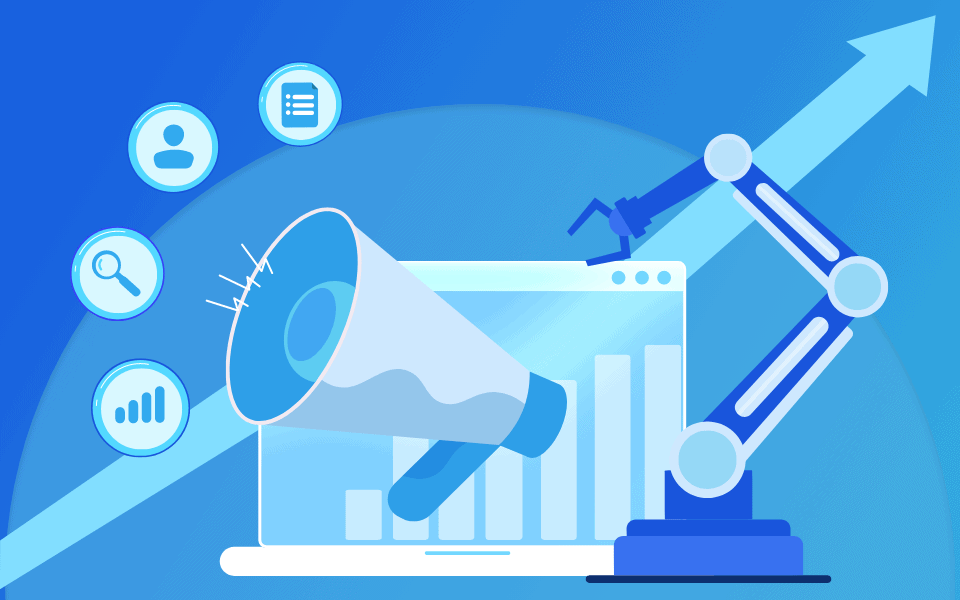Subscribe to Our Newsletter
Stay updated with the latest tips and strategies. Get additional discounts and alerts on offers.

How many marketers are aware of the concept of marketing automation and the types of marketing automation campaign? Almost 86.1% of marketers implement marketing automation campaigns. If you belong to the other 14% of marketers, we are here to help you!
Every marketer understands the multitasking required to reach the right target audience. Engaging prospects throughout the funnel without a break can be tedious, tiring, and even energy-draining. It is not a myth when marketers say that marketing automation is a friend that helps them survive in business.
Digital marketing may attract prospects via multiple channels. However, streamlining them into appropriate funnel stages and engaging in meaningful conversations can be tedious. Marketing automation ensures that you can focus on more pressing tasks in these scenarios. In contrast, marketing automation assists in engaging and filtering prospects into the proper stages with its analytics and programming.
A marketer cannot add more hours to a day, yet they can now stay on top of their game with the help of automation. It is time to focus on the bigger picture, build stronger customer relationships, and increase sales. Let us discover the power of marketing automation campaigns.
To do this, we must first understand what marketing automation is.
Marketing automation is implemented via multiple software. These streamline marketing processes, including campaign management, audience segmentation, lead scoring, behavioral analysis, and website monitoring.
Marketing automation software works towards replacing manual labor in repetitive tasks. It empowers marketers by reducing resource depletion and saving time. This makes campaigns effective and helps deliver the right content to the right inbox without interference. Marketing automation involves reducing stress in omnichannel marketing in the digital landscape.
Did you know? Marketing automation can decrease your cost per lead by 33% and increase sales leads by 80%! Such statistical details only prove the point further – Marketing automation has more advantages to offer to any business willing to explore its impressive features.
Ultimately, it creates a fertile ground of data for you to build healthy, long-term relationships with customers that generate revenue, profits, and a ripe network for promoting your products and services.
To further your marketing journey and enhance seamless integration of marketing automation software, you would need your data to be free of incomplete or irrelevant data. Check How We Can Help You with Clean Data!
Acquiring new customers into your business with a low churn rate is essential to keep your profits up and running. One of the significant strategies to keep your customer engaged is to understand their challenges, concerns, and pain points. By addressing these shortcomings in your campaigns, you can send compelling messages and resources that instantly attract them to your product, solution, or brand.
Pain points can arise from various sources such as:
Customer pain points are a gap you need to address with your solution. To do so effectively, a study on the customers’ pain points can clearly give you the solution to promote your product and help you address B2B Customer Pain Points.
The solution is simple – Understand where the customer is and where they want to be. With this simple statement, companies can build loyal and satisfied customers who are bound to return for solutions soon.
There are specific methods using marketing automation to study and draw a map of customer pain points:
The marketing sphere and scope are significant, and different types of marketing automation can bring different benefits to your business.
Today, we discuss important types of marketing automation campaign that can benefit you through leads and conversions, allowing you to grow, network, and expand!
Why Should You Implement Marketing Automation? The answer is simple – Implementing marketing automation gives you and your team more time to focus on tasks that require your undivided attention.
Lead generation and nurturing are the basis of what a business keeps up and running for revenue. It takes the highest priority in marketing processes. The priority of lead management automation is to automate the acquisition and qualification of leads. Once your parameters for qualifying leads are set by the team, you can go ahead and set your relevant triggers. The rest is taken care of by marketing automation.
Now, the marketing automation software engages the customer by sending out triggers for each action the customer takes. With this help, you will now not miss out on any opportunities that come your way!
This works out for a marketer when they follow the following religiously:
Master the Art of Lead Nurturing and upscale your business outreach and prospecting journey.
Customer retention campaigns are created to ensure the customer does not convert to a competitor brand for the same product. Another reason these campaigns are implemented is that they cost 5 – 25x less than acquiring new customers.
With different types of marketing automation campaign, customer retention is a metric that is often used by businesses to value the overall success rate over a period of time. It widely differs from customer acquisition and lead generation.
The formula to calculate customer retention rate is –
Customer Retention Rate = (Total # of Customers at the end of the Period – New Customers Acquired) / Customers at the Start of the Period (HubSpot)
Various factors influence the customer retention rate in the B2B industry. Some of them include:
Here are how customers can be retained successfully:
It is essential for a business to succeed in implementing tactics that help retain customers. It assists in reducing churn rates. All it takes is to improve customer experiences by learning the techniques to Retain Customers!
E-commerce campaigns are crucial to online store growth. They generate leads, nurture them, and engage customers online for sales. Without proper implementation, e-commerce marketing automation could lead to human errors, low productivity, and inefficiency. It tracks inventory, triggers re-orders, automatically fulfills orders, and sends automated emails to customers.
Here are some proven marketing automation strategies that can work in real-time for your company and a wide range of types of marketing automation campaign:
And then there are days when marketers require a slight jog down the memory lane for business. Check out our blog specially written to help you refresh and familiarize yourself with ABM again!
Email marketing is widely accepted for communications between a company and a prospect or customer. Internally, email marketing automation eliminates repetitive tasks that come with triggers from customers.
A platform dedicated to email automation comes with templates that are uploaded for marketing campaigns. It is customizable and enables dynamic emails to be triggered by customer’s actions. One can add, delete, or edit any element in the template for a better customer experience. Added bonus? It works with different types of marketing automation campaign with ease!
If you are struggling to make the first contact with customers via emails, we provide just the right templates required for your cold email marketing efforts. Check it out now!
Prospects tend to interact multiple times before they convert to a particular brand. Here, drip campaigns help you share content based on your company, product, trends, industry insights, and more. With pre-defined parameters for your automation, set up different templates and emails to be triggered by customers’ actions.
To make your interactions smooth and perfect with your customers, we have 20+ effective sales follow-up email templates that can cut short your time spent and engage your customers simultaneously. Check it out today!
What is CRM marketing automation?
CRM and marketing automation may seem similar, yet they are different from each other. When brought together and aligned perfectly, their work together can turn things around for your business.
If you are looking to get quick access to data, insights, feedback, and customer demographics, CRM is the best option to have in your campaign. It helps streamline tasks, generate more leads, and boost conversions. It gives you instant access to email addresses and purchase history.
CRM enables you to score your leads and track where a specific lead is in the sales funnel. This, in turn, helps send out relevant content to the prospect that aids in faster conversions.
Go ahead and download our CRM email templates for free and discover how your marketing efforts score you leads that lead you to increased profits and ROI!
Multi-channel marketing aims to ensure the customer gets a unified marketing experience on multiple channels. By automating the multi-channel marketing strategy, one can ensure that the customer base is segmented and that they experience personalized marketing communications. It also ensures you don’t bombard the customer and that you can alternatively schedule messages.
Here are some tips to ensure you get the most out of multi-channel marketing automation –
Integrate the tips and our expert curated marketing mix templates for a great multi-channel marketing venture. Execute campaigns that engage and convert prospects to customers with ease!
Today, an overwhelming amount of data reaches organizations and marketers. Sifting through them, segmenting, and implementing campaigns can be a risk of human errors leading to campaign failure. This has led to a constant search for optimization of advertising campaigns.
Implementing machine learning and artificial intelligence has helped marketers make data-driven decisions without overwhelming them. These technologies provide marketers with tools that help automate tasks, analyze data, and provide insights into customer behavior and preferences.
Here is how AI and machine learning help optimize all types of marketing automation campaign–
Another reason that automated campaigns can fail is poor data quality. It can be inaccurate, incomplete, or outdated. One way to overcome this is by purchasing email lists from reputable database providers such as DataCaptive. You can acquire accurate, updated, verified, and credible data from various industries, professions, job titles, etc.
A/B testing different types of marketing automation campaign for content and visuals are acceptable and perceived positively by your customers. Failure to do A/B testing can lead to you sending messages that do not resonate with your audience. This can lead to lower response rates, open rates, or even lower conversions, leading to a loss for your company.
There are mainly six types:
No marketing campaign is successful without the right automation tools and platforms to implement it. Our study by experts explains why choosing the right automation platform like DataCaptive can help you enhance your engagement, conversions and ROI!
Various types of marketing automation campaign can be your best friend in marketing. It can be the backbone that values time, effort, and resources for growth. With us, you can explore types of marketing automation for B2B companies and industries. All you need to do is invest your resources in the right place with marketing automation.
If you feel that investing in software you are unaware of can cost a lot, you are in the right place. You can easily reach the right target audience with our marketing automation services! Leave the heavy lifting to us!
Don’t limit yourself! Embrace technology, data, and automation to get success in your marketing campaigns now!
Show Some Love!

Subscribe to Our Newsletter
Stay updated with the latest tips and strategies. Get additional discounts and alerts on offers.
Related Articles
Subscribe to Newsletter
Stay up to date with the latest marketing, sales, and service tips and news.
